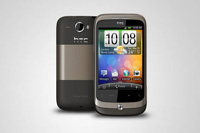HTC Wildfire review
The HTC Wildfire is HTC’s latest budget Android phone, but does it rectify all of the HTC Tattoo’s problems?

The HTC Wildfire brings the looks of the Desire, with a budget twist. It runs perfectly well on Android 2.1 and battery life is ample. However, the screen is the Wildfire’s biggest failure and if you do stare at text all day, you may find that you have to step up a notch to the HTC Desire or even Legend.

Another area where HTC has scrimped a little is in the processor, packing the standard Qualcomm MSM 7225 528MHz, which is the same as the Hero. Some could judge scrapping the 1GHz Qualcomm Snapdragon powerhouse as a major issue, but we found it to be just as snappy as the Desire.
This could well be because there isn't such a large, high-powered screen to support, or it could be that the Wildfire just manages processes better, but swapping between apps wasn't a problem. Nor did we experience delays within apps.
The one foible we found with the processor though, was that the accelerometer sometimes struggled the flip from landscape to portrait. Although this wasn't a major issue, it could become one if you have a short fuse.
A handy extra you get with the HTC Wildfire over the HTC Desire is that it offers a turn to mute option, which could prove a useful feature for meetings. If a call comes in while you're busy, you can simply turn the phone over and the ringer will mute. We found it to be very responsive and a much better way to ignore a call rather than pressing the call end button.
RAM also loses out here. The Desire includes 576MB RAM and 512MB ROM, while the Wildfire's memory is stepped down a notch sporting 384MB RAM and 512MB ROM. There are no massive detrimental effects that we were able to identify although with permanent usage you may find it doesn't perform as well as the Desire.
Get the ITPro daily newsletter
Sign up today and you will receive a free copy of our Future Focus 2025 report - the leading guidance on AI, cybersecurity and other IT challenges as per 700+ senior executives

Clare is the founder of Blue Cactus Digital, a digital marketing company that helps ethical and sustainability-focused businesses grow their customer base.
Prior to becoming a marketer, Clare was a journalist, working at a range of mobile device-focused outlets including Know Your Mobile before moving into freelance life.
As a freelance writer, she drew on her expertise in mobility to write features and guides for ITPro, as well as regularly writing news stories on a wide range of topics.
-
 Cleo attack victim list grows as Hertz confirms customer data stolen – and security experts say it won't be the last
Cleo attack victim list grows as Hertz confirms customer data stolen – and security experts say it won't be the lastNews Hertz has confirmed it suffered a data breach as a result of the Cleo zero-day vulnerability in late 2024, with the car rental giant warning that customer data was stolen.
By Ross Kelly Published
-
 Women show more team spirit when it comes to cybersecurity, yet they're still missing out on opportunities
Women show more team spirit when it comes to cybersecurity, yet they're still missing out on opportunitiesNews While they're more likely to believe that responsibility should be shared, women are less likely to get the necessary training
By Emma Woollacott Published
-
 OpenAI wants developers using its new GPT-4.1 models – but how do they compare to Claude and Gemini on coding tasks?
OpenAI wants developers using its new GPT-4.1 models – but how do they compare to Claude and Gemini on coding tasks?News OpenAI says its GPT-4.1 model family offers sizable improvements for coding, but tests show competitors still outperform it in key areas.
By Ross Kelly Published